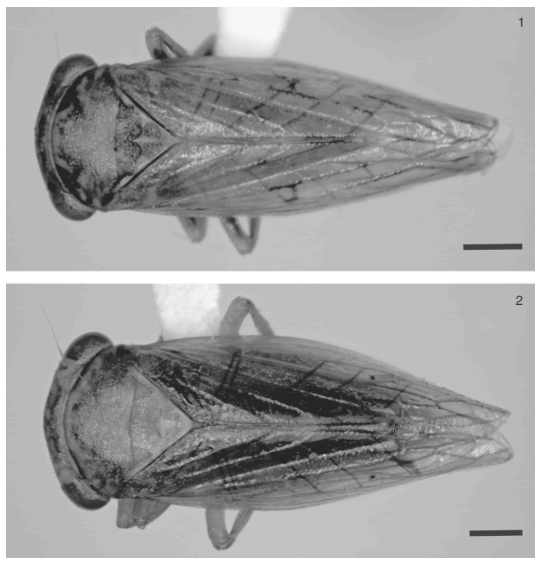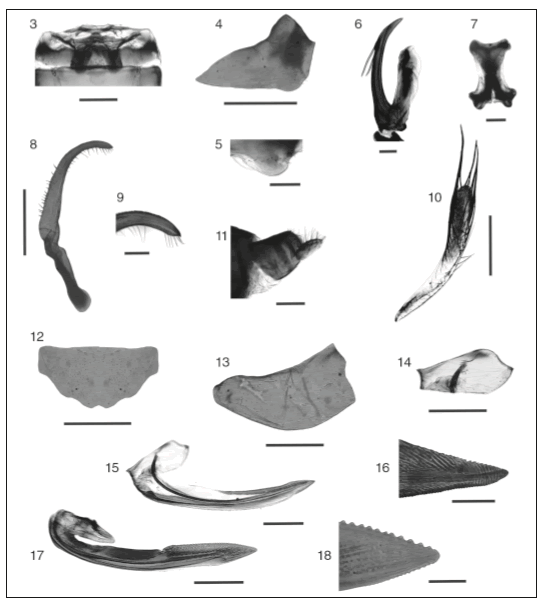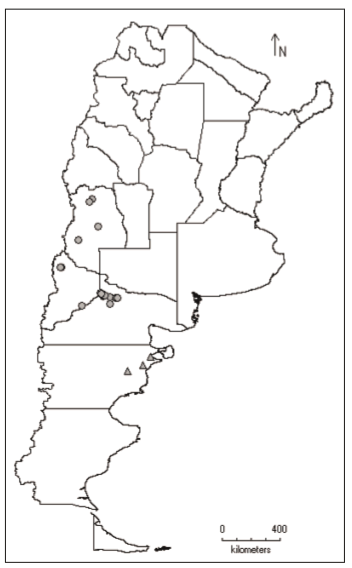Servicios Personalizados
Revista
Articulo
Indicadores
-
 Citado por SciELO
Citado por SciELO
Links relacionados
-
 Similares en
SciELO
Similares en
SciELO  uBio
uBio
Compartir
Revista de la Sociedad Entomológica Argentina
versión impresa ISSN 0373-5680
Rev. Soc. Entomol. Argent. vol.74 no.1-2 La Plata jun. 2015
TRABAJO CIENTÍFICO
Redescription of Rhytidodus decimusquartus (Hemiptera: Cicadellidae: Idiocerinae) and new distributional records from Argentina
Redescripción de Rhytidodus decimusquartus (Hemiptera: Cicadellidae: Idiocerinae) y nuevos registros de distribución geográfica de la Argentina
Paradell, Susana L.1 & Gimena Dellapé2
1División Entomología, Museo de La Plata, Facultad de Ciencias Naturales y Museo, UNLP, Paseo del Bosque, B1900FWA La Plata, Argentina. Comisión de Investigaciones Científicas de la provincia de Buenos Aires (CIC). E-mail: paradell@fcnym.unlp.edu.ar
2Centro Nacional Patagónico, CENPAT-CONICET, Bvd. Brown 2915, U9120ACDA Puerto Madryn, Argentina. Consejo Nacional de Investigaciones Científicas y Técnicas (CONICET). E-mail: gimenadellape@gmail.com
Recibido: 14-X-2014
Aceptado: 30-IV-2015
ABSTRACT. Rhytidodus decimusquartus (Schrank) is the only representative of the subfamily Idiocerinae in Argentina, which inhabits on "poplars" in the western part of Mendoza, Neuquén and Río Negro provinces. In this contribution, we provide a detailed morphological redescription of this species for easy identification from material collected in Argentina; some characters of the female genitalia are described for the first time. Additionally, new records from the southeastern region of this country are provided.
KEY WORDS: Auchenorrhyncha; Leafhoppers; Salicaceae; Populus sp.
RESUMEN. Rhytidodus decimusquartus (Schrank) es el único representante de la subfamilia Idiocerinae de la Argentina y habita sobre "álamos" en la región oeste de las provincias de Mendoza, Neuquén y Río Negro. En esta contribución se provee una redescripción morfológica detallada de la especie para facilitar su identificación. Algunos caracteres de la genitalia femenina son descritos por primera vez. Adicionalmente se dan a conocer nuevos registros del sudeste del país.
PALABRAS CLAVE: Auchenorrhyncha; Chicharritas; Salicaceae; Populus sp.
INTRODUCTION
Cicadellidae is one of the largest families of insects with more than 22.000 known species, which is divided currently in 26 subfamilies (Dietrich, 2004, 2005). Idiocerinae is one of the smallest subfamilies of Cicadellidae, with approximately 90 genera and 750 known species worldwide (Dietrich, 2000; Zhang & Viraktamath, 2009), of which 67 species are represented in the Neotropical region (Freytag & Sharkey, 2002).
The members of Idiocerinae are arboreal forms, phloem feeders, and mainly breed on trees and shrubs (Viraktamath, 2007). This subfamily includes economically important species causing serious losses to fruit crops as Idioscopus nitidulus (Walker), I. clypealis (Lethierry), I. nagpurensis (Pruthi), Amritodus atkinsoni (Lethierry) and A. brevistylus Viraktamath affecting "mango" Mangifera indica L. (Anarcadiaceae) in certain parts of the Oriental and Australian regions (Gnaneswaran et al., 2007; Zhang & Viraktamath, 2009). Many species are known to be associated with the dominant tree genus Eucalyptus (Myrtaceae) in New Zealand and Australia (Evans, 1963; Knight, 2010). In South America (Brazil, Paraguay, Bolivia, Chile and Argentina), species of Idiocerinae occur mostly on Salicaceae such as "poplars" (Populus spp.) and "willows" (Salix spp.) (Metcalf, 1964; Viraktamath, 2007; Ortego et al., 2011).
In Argentina the subfamily Idiocerinae was recorded by Dapoto et al. (2011) and Ortego et al. (2011). They reported the occurrence of a large number of specimens of Rhytidodus decimusquartus (Schrank) flying towards the light sources inside homes and shops causing severe inconvenience to residents and tourists, as well as on "Creole poplar" (Populus nigra L.) causing significant defoliations and yellowing in Mendoza, Neuquén and Río Negro provinces. Rhytidodus decimusquartus is also distributed in Europe, Africa, Australia, New Zealand and North America, and has been associated with the transmission of the disease of decay of "poplar" (Poplar Phytoplasma Diclain) in France and Italy (Cousin et al., 1999; Wientraub & Beanland, 2006; Knight, 2010). How R. decimusquartus was introduced in Argentina is not known but one possibility is that it arrived in propagation material of P. nigra (cuttings) as wintering egg from Europe (Ortego et al., 2011) as was reported for North America (Hamilton, 1980).
Freytag (1965) provides a general description of R. decimusquartus and describes some characters of the male genitalia, and pygofer and seventh sternum of female. In this contribution, we describe for the first time characters of the female genitalia neglected until now, these are: first valvulae and valvifer, second valvulae and valvifer, and sculpturing pattern area of second valvulae. We also provide a detailed morphological description of this species for an easy identification and new distributional records.
MATERIALS AND METHODS
The material studied came from samplings conducted by the authors in southeastern Argentina, as well as specimens submitted by researchers from the southwest of the country. For morphological study, 10 specimens of each sex were measured from the anterior margin of crown to apex of the wings. The entire abdomen was dissected and clarified in a solution of 10% KOH at room temperature for observation of the genital structures. Photographs were taken using a Cannon Rebel T3i digital camera mounted on a Zeiss stereomicroscope. Morphological terminology follows Freytag (1965) and Dietrich (2005). The studied specimens were deposited in the Entomological Collection of Museo de La Plata, Argentina (MLP).
RESULTS
Rhytidodus Fieber
Rhytidodus Fieber, 1872: 8.
Type-species: Cicada decimaquarta Schrank 1776, by subsequent designation of Zachvatkin 1953: 213.
Rhytidodus is distinguished by the length and position of the pronotal suture; pygofer on lateral view with a lateral expansion; apophysis of style curved outward; and aedeagus with processes on the shaft (Freytag, 1965).
Rhytidodus decimusquartus (Schrank)
Cicada decimaquarta Schrank, 1776:137.
Jassus scurra Germar, 1837: 11.
Jassus crenatus Germar, 1837: 10.
Idiocerus germari Fieber, 1868: 451.
Idiocerus scurra fulvus Rey, 1894: 30.
Idiocerus gemmisimulans Leonard & Crosby, 1915: 542.
Rhytidodus decimusquartus (Schrank) Nast, 1972: 215.
Schrank (1776) describes this species using just a few characters, mainly of coloration. Later, Freytag (1965) provides a general description and describes some characters of male genitalia, and pygofer and seventh sternum of female. Knight (2010) cites this species in the checklist of the leafhoppers recorded in the Pacific region.
Male (Fig. 1). Length: 6.5-9 mm. General color pattern olive brown, with darker brown markings on head, pronotum and scutellum. Head width 2,6 mm, crown yellowish, rounded and very slightly produced in middle; width between ocelli 1,08 mm, width between antennae 1,41 mm; postclypeus broadly rounded wider than long, anteclypeus twice longer than wide, with median concavity in the apex. Pronotum rugose, anterior margin of disc yellowish, laterally with two black elongated oblique spots, lateral margins dark. Scutellum yellow, sometimes with two brownish enlarged lateral spots, disc with two dark rounded spots. Abdomen black in dorsal view, yellow in lateral areas, and yellowish in ventral view. Forewing olive brown, venation yellowish with scores, spots dark distributed irregularly, wide appendix. First sternal complex (Fig. 3) with sternal bar thin, strong and sclerotized, dorsal apodeme well developed, rounded and sclerotized, with one small and sclerotized spine on ventral margin; medial notch shallow. Second sternal complex (Fig. 3) with dark quadrate and short processes tongue-sharp, margins parallel, obliquely truncate tips, reaching third segment. Genitalia: valve in lateral view triangular, microsetae on disc, rounded apex. Pygofer (Fig. 4) rectangular or triangular, truncate-rounded terminally in lateral view, with uniseriate group of four to six macrosetae on posteroventral margin, with a whitish rounded lateral expansion (Fig. 5), surface striate, a few microsetae on the disk.

Figs. 1-2. Rhytidodus decimusquartus (Schrank). 1, male; 2, female. Scale: 1mm.

Figs. 3-18. Male: 3, sternal complex; 4, pygofer; 5, lateral expansion of pygofer; 6, aedeagus; 7, connective; 8, style; 9, apex of style; 10, subgenital plate; 11, anal segment. Female: 12, seventh sternum; 13, pygofer; 14, first valvifer; 15, first valvulae of ovipositor; 16, apex of first valvulae; 17, second valvulae of ovipositor; 18, apex of second valvulae. Scales 3, 4, 8, 10, 12, 13, 14, 15, 17: 0,5mm; 5, 6, 7, 9, 11, 16, 18: 0,1mm.
Subgenital plate (Fig. 10) elongated, narrow, lightly curved to half apex, expanded apically, extending beyond the pygofer, fine and short setae on the disc, very long and thin numerous setae, irregularly arranged forming a tuft at the apex rounded. Style (Fig. 8) narrow throughout its length, basal part strongly sclerotized, apophysis abruptly curved posteroventrally, apical third with microsetae on the outer margin, row of finer subapical macrosetae along inner margin, from start curved until apex, microsetae disperse on the disc, rounded denticles on the dorsal margin until third apical, apex with one sclerotized and curved spine (Fig. 9). Connective (Fig. 7) narrows, horseshoe-shaped. Aedeagus (Fig. 6) in lateral view, socle small, apodeme expanded until third apical to shaft, shaft curved to apex, a pair of apical processes long, thin and parallel directed anterior and ventrally, reaching beyond the mid-shaft; gonopore rounded and apical. Anal segment (Fig. 11) developed with sclerotized lateral margins.
Female (Fig. 2). Length: 7.5-10 mm. Shape and general color pattern similar to male but lighter, less prominent spots. Genitalia: seventh sternum (Fig. 12) wider than long, broadly rounded, disc with numerous microsetae, posterior margin with a median deep notch V-shaped inverted, deeply sinuous on both sides, lateral angles rounded and pronounced. Pygofer (Fig. 13) in lateral view, rectangular concavely rounded towards the apex. Valvulae of ovipositor exceed length of pygofer. First valvula (Fig. 15) thin along its length, apex with countless acute microteeth on dorsal and ventral margins, apex acute (Fig. 16); well delimited sculptured submarginal area since it begins to curve toward the apical third on the apical area. First valvifer (Fig. 14) rectangular, angles rounded with one sclerotized spine in the apex. Second valvula (Fig. 17) thin in basal region, with a deep notch in "V" sharp on the dorsal margin in the base of the apical area, widening towards the apex abruptly, dorsal margin with numerous strong and small rounded teeth, on the apical third in ventral margin with countless denticles, narrowshaped apex (Fig. 18); sculpturing pattern with rounded large, well delimited maculae separate each one and row regularly arranged on the apical sculpturing area. Second valvifer ovoid and strongly sclerotized, with a group of strong microsetae in medial area.
Remarks. R. decimusquartus is distinguished by the pygofer of male with rounded lateral expansion; subgenital plate elongated, with very long and thin setae irregularly arranged forming a tuft; basal portion of style strongly sclerotized, apex with one spine, sclerotized and curved; aedeagus with a pair of apical processes long, thin and parallel directed anterior and ventrally, reaching beyond the mid-shaft; second valvula of female with a deep notch V-shaped sharp in middle of dorsal margin; dorsal margin with numerous strong and small rounded teeth, on the apical third in ventral margin with countless denticles, sculpturing pattern with rounded large, well delimited maculae.
Distribution in Argentina (Fig. 19) Mendoza: Malargüe, Uspallata, San Rafael, Guaymallén, Luján de Cuyo. Neuquén: Confluencia, Centenario, Vista Alegre, Huinganco, Andacollo. Río Negro: Cinco Saltos, Cipolletti, General Roca, General Fernandez Oro, Ingeniero Huergo, Villa Regina, Pomona (Dapoto et al., 2011; Ortego et al., 2011). New record for Chubut province: Puerto Madryn, Gaiman, and Dique Ameghino.

Fig. 19. Distribution of Rhytidodus decimusquartus (Schrank) in Argentina: • known distribution; ▲ new records.
Material examined. ARGENTINA. Mendoza: Uspallata, IV-2008, Corbalán V. leg., 1 male, 3 females; same locality, V-2008, Corbalán V. leg., male, 5 females; same locality, on Populus sp., Bertolucci A. leg., 15 males, 11 females; Malargüe, IV-2008, on P. nigra var. Italica, Corbalán V. leg., 1 male, 6 females. Río Negro: Villa Regina, General Roca, V-2010, on Populus sp., Fernandez D. leg., 2 females, 1 nymph III, nymph V; same locality, 19-V-2010, on Populus sp., Dapoto leg., 1 male; Alto Valle, 10-V-2011, Bouvet J.P.R. leg., 5 males, 3 females. Chubut: Puerto Madryn, 1-V-2012, Dellapé G. leg., 1 male; same locality, 22-IV-2014, Dellapé G. leg., 1 male, 3 females; Gaiman, 18-VII-2012, within Allium ampeloprasum var. porrum (L.) J. Gay with Populus sp. acting as a wind curtain, Dellapé G. leg., 11 males, 14 females; Dique Ameghino, 6-II-2014, on Populus sp., Dellapé G. leg., 10 males, 9 females.
ACKNOWLEDGEMENTS
This research was supported in part by Comisión de Investigaciones Científicas de la Provincia de Buenos Aires (CIC), Consejo Nacional de Investigaciones Científicas y Técnicas (CONICET) and Grant 11 N/723 of UNLP, Argentina. We thank the reviewers for their helpful comments and suggestions.
LITERATURE CITED
1. COUSIN, M. T., R. BERGES, J. ROUX, J. P. MOREUA & C. HIRUKI. 1999. Populus nigra L. Italica decline in France phytoplasma responsible for the disease in Europe. Results and perspectives. Acta Horticulturae 496: 77-86. [ Links ]
2. DAPOTO, G., A. OLAVE & M. BONDONI. 2011. Plagas de las Salicáceas en Patagonia Norte. Importancia de los principales artrópodos presentes en los valles irrigados del Río Negro y del Neuquén. In: Jornadas de Salicáceas - Tercer Congreso Internacional de Salicáceas en Argentina, Neuquén, 2011, Disertación . [ Links ]
3. DIETRICH, C. H. 2000. Guide to the subfamilies of leafhoppers (Cicadellidae). Center for Biodiversity, Illinois Natural History Survey. Available from: http://www.inhs.uiuc.edu/~dietrich/subfam/guide.html [accessed 26 September 2014] [ Links ]
4. DIETRICH, C. H. 2004. Phylogeny of the leafhopper subfamily Evacanthinae with a review of Neotropical species and notes on related groups (Hemiptera: Membracoidea: Cicadellidae). Systematic Entomology 29: 455-487. [ Links ]
5. DIETRICH, C. H. 2005. Keys to the families of Cicadomorpha and subfamilies and tribes of Cicadellidae (Hemiptera: Auchenorrhyncha). Florida Entomologist 88: 502-517. [ Links ]
6. EVANS, J. W. 1963. The Zoogeography of New Zealand Leafhoppers and Froghoppers (Insecta, Homoptera, Cicadelloidea and Cercopoidea). Proceeding of the Royal Society of New Zealand (Zoology) 3 (9): 85-91. [ Links ]
7. FIEBER, F. X. 1868. Europäische neue oder wenig bekannte Bythoscopida. Verhandlungen der Kaiserlich-Koniglichen Zoologisch-botanischen Gesellschaft in Wien 18: 449-464. [ Links ]
8. FIEBER, F. X. 1872. Katalog der europäischen Cicadinen, nach originalien mit Benutzung der neuesten Literatur. Carl Gerold's Sohn, Viena. [ Links ]
9. FREYTAG, P. H. 1965. A Revision of the Nearctic species of the genus Idiocerus (Homoptera: Cicadellidae: Idiocerinae). Transactions of the American Entomological Society 91: 361-430. [ Links ]
10. FREYTAG, P. H. & M. SHARKEY. 2002. A preliminary list of the leafhoppers (Homoptera: Cicadellidae) of Colombia. Biota Colombiana 3(2): 235-283. [ Links ]
11. GERMAR, E. F. 1837. Jassus crenatus Germ., Jassus scurra Germ., Jassus puncticeps Germ., Jassus nassatus Germ., Jassus cereus Germ., Jassus assimilis Fall., Jassus subrusticus Fall., Jassus albiger Germ., Jassus ocellatus Scop., Jassus abdominalis Fab., Jassus aureoles Fall. Agusti Ahrensii Fauna Insectorum Europae 17: 10-20. [ Links ]
12. GNANESWARAN, R., K. S. HEMACHANDRA, C. A. VIRAKTA-MATH, D. AHANGAMA, H. N. P. WIJAYAGUNASEKARA & I. WAHUNDENIYA. 2007. Idioscopus nagpurensis (Pruthi) (Hemiptera: Cicadellidae: Idiocerinae). A new member of mango Leafhopper complex in Sri Lanka. Tropical Agricultural Research 19: 78-90. [ Links ]
13. HAMILTON, K. G. 1980. Review of the Neartic Idiocerini, excepting those from the Sonoran subregion (Rhynchota: Homoptera: Cicadellidae). Canadian Entomologist 112: 811-848. [ Links ]
14. KNIGHT, W. J. 2010. Leafhoppers (Cicadellidae) of the Pacific. An annotated systematic checklist of the leafhoppers recorded in the Pacific region during the period 1758-2000. Available from. http://www.tymbal.org/publicat/KnightCatalogue.pdf [accessed 26 September 2014] [ Links ]
15. LEONARD, M. D. & C. R. CROSBY. 1915. A new species of Gonatocerus (Mymaridae) parasitic on the eggs of a new species of ldiocerus (Bythoscopidae) feeding on poplar. Journal of Economic Entomology 8: 541-547. [ Links ]
16. METCALF, Z. P. 1964. General Catalogue of the Homoptera. FascicIe VI. Cicadelloidea. Bibliography of the Cicadelloidea (Homoptera: Auchenorrhyncha). United States Department of Agriculture, Agricultural Research Service, USA. [ Links ]
17. NAST, J. 1972. Paleartic Auchenorrhyncha (Homoptera): An annotated Check List. Institute of Zoology, Polish Scientific Publisher, Warsaw. [ Links ]
18. ORTEGO, J., G. KUNTZ, P. LOZADA & A. R. CASTAÑO GAÑAN. 2011. Primer registro en Sudamérica de Rhytidodus decimusquartus (Schrank, 1776) (Hemiptera: Cicadellidae: Idiocerinae), una "chicharrita" que afecta a los álamos. In: Jornadas de Salicáceas - Tercer Congreso Internacional de Salicáceas en Argentina, Neuquén, 2011, pp. 1-7. [ Links ]
19. SCHRANK, F. V. P. 1776. Cicada. Beytrage zur Naturgeschichte 1776: 1-137. [ Links ]
20. REY, C. 1894. Remarques en passant. Echange 10: 29-30. [ Links ]
21. VIRAKTAMATH, C. A. 2007. New genera and species of Idiocerine Leafhoppers (Hemiptera: Cicadellidae) from India, Sri Lanka and Myanmar. Biosystematica 1 (1): 21-30. [ Links ]
22. WIENTRAUB, P. G. & L. BEANLAND. 2006. Insects vectors of Phytoplasmas. Annual Review of Entomology 51: 91-111. [ Links ]
23. ZACHVATKIN, A. A. 1953. Cikadiny okskogo gosundarstvennogo zapovednika. In: Sbornik nauchnykh rabot, Moskova, pp. 211-223. [ Links ]
24. ZHANG, B. & C. A. VIRAKTAMATH. 2009. New placement of the leafhopper genus Idioceroides Matsmura (Hemiptera: Cicadellidae: Idiocerinae), with description of a new species. Zootaxa 2242: 64-68. [ Links ]













